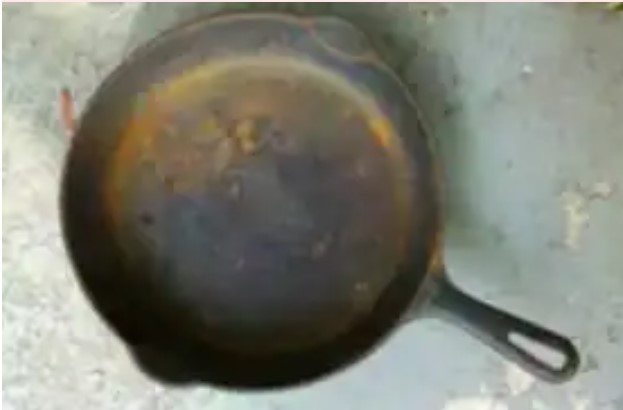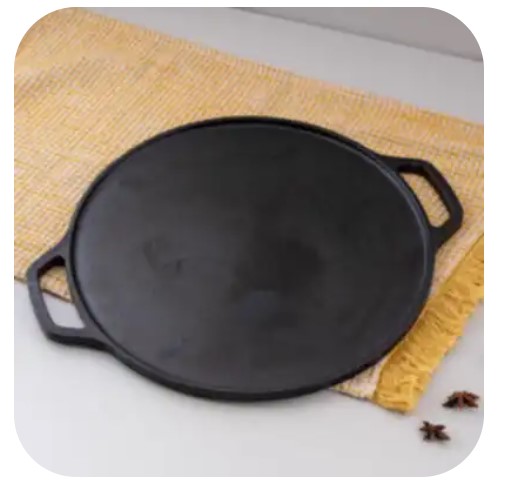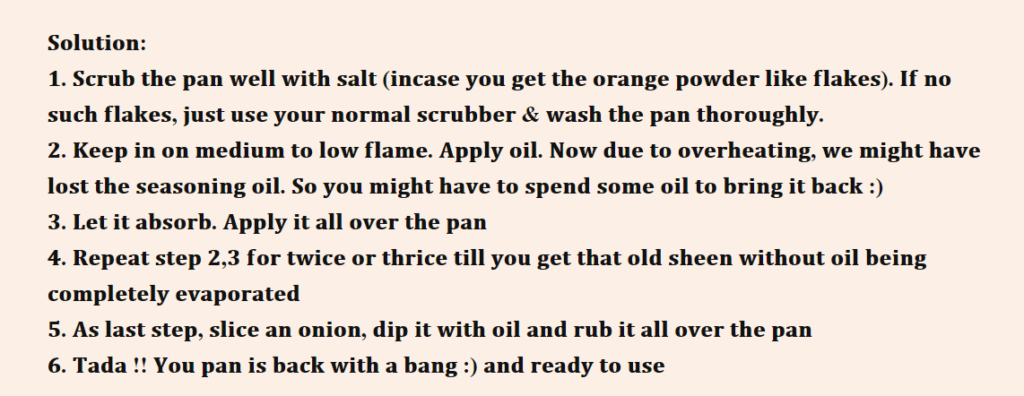Myths Busted
1. Myth: Don’t use soap to clean the cast iron cookware
Fact: You can very well use your everyday dishwashing soaps or liquid dishwashing liquids and wash them like other utensils
2. Myth: Seasoning is a tiring process
Fact: Our products are pre seasoned. In case there occurs a situation in future when you want to re-season them, its very simple. Scrub & wash them well. Pat dry, Saute onions in oil under low flame. Its ready to use. Its so ‘easy-peasy’ to re-season the cast iron
3. Myth: Cast iron cookware takes longer time to get heated up
Fact: Cast iron has very good thermal conductivity. So, it gets heated up quickly just like other vessels (in fact much quicker). Also, it retains heat for longer time when compared to other utensils hence reduces fuel consumption
4. Myth: Don’t use metal spatula
Fact: Using metal spatulas are absolutely fine. Those cannot damage your pan. Nothing can damage your cast iron pan unless & until it’s dropped from second floor 😊
5. Myth: Cast iron cookware cannot be 100% non-stick
Fact: Cast iron cookware ages like fine wine. If it is well maintained, it acts much better than other vessels
6. Myth: You cannot use cast iron pans on glass top stoves Cast iron cookware works on oven, glass tops, induction. Its just that handle with care so that your cooking range stay safe.
7. Myth: You cannot cook acidic or alkaline foods on cast iron
Fact: Food, in a well-seasoned cast iron pan comes in contact with the polymerized layer (oil) and not the metal. However, there are some chance that some spots of bare metal interact with the acidic ingredients of the food and give some metal taste to the food. So, try to avoid tamarind and citrus based dishes alone in the cast iron.
8. Myth: Cast iron cookware is unbreakable
Fact: Cast iron is unbelievably durable but its brittle. Do not intentionally try to drop it from height. It breaks before it bends.
What not to cook in cast iron?
- Acidic foods like tamarind, tomato, lemon cause more iron to leach into the food, which is said to alter the taste of the food. These foods may break the seasoning layer of the pan
- Tomatoes when mixed with other ingredients while cooking curries is absolutely fine. But pure tomato sauce-based dishes can be avoided
- Change the food to the serving bowl after being cooked. Don’t leave the food for long hours on cast iron which may tend to change the color of the food slightly
How to clean the cast iron cookware?
- You can clean the cast iron cookware just like washing your other utensils. No special attention required
- CAST IRON COOKWARE ARE NOT DISHWASHER FRIENDLY. So please don’t use the dishwasher to wash them.
- Metal scrubbers, normal scrubbers all are welcome!
- Do not soak the cast iron cookware in water for long time as it may form rust
- Wash them thoroughly
- Pat dry it very thoroughly. MOISTURE RETENTION will cause iron pan to RUST
- Grease the cast iron pan with few drop of oil (I usually pat dry and grease the bowl area/cooking area alone with oil ! )
- Store it in dry place
Hack: If you feel, your pan is so heavy to lift it and dry it all over, follow this simple hack. After washing the cookware, simply put the pan on the low flame for about 10 seconds till it gets hand-bearing heat. All water will evaporate in that heat !! Tada ! its done. Just grease it with oil & store it. As simple as that.
How to restore a rusty cast iron cookware?

Incase the rust is Mild..
- Wash it thoroughly using steel/iron scrubber & dishwashing liquid
- Dry it well
- Heat it on low flame
- Sauté some chopped onions and apply that excess oil all over the pan (including handle, lid, outside the pan)
- Let it cool. Your pan will be restored

Incase the rust is Heavy…
Method 1
- Sprinkle some sea salt to the pan
- Cut a potato into half.
- Place the potato on the cut side down on the salt & scrub it very well all over the pan. Coarse sea salt acts as natural abrasive, while potato which has natural chemical called oxalic acid to breakdown the rust & dissolve it. Together they act as scrub
- Wash this off with soap
- Heat it on low flame and apply oil all over the pan including handle, lid outside of the pan
- Cool it !! Your pan is restored
Incase the rust is too Heavy…
- Sprinkle good amount of baking soda all over the pan
- Add vinegar. Let this combo soak for around 30 mins
- Later, wash it off with soap
- Dry it well.
- Heat it on low flame and apply oil all over the pan including handle, lid outside of the pan
- Cool !! Your pan is restored
If your pan needs severe help & if its sooper dooper rusty, then soak the pan in vinegar + baking soda overnight. Next day morning wash it off
Heat it on low flame and apply oil all over the pan including handle, lid outside of the pan
Cool !! Your pan is restored
Conclusion: So any type of issue with cast iron can be fixed. Cast iron is something that needs to travel for generations. Don’t discard them off 🙂
Can we use the same tawa for dosa and fish fry?
My sincere advice is to use different tawa for both
Resaon : Temprature at which other foods like fish fry, rotis cooked are different from that of dosa
So when you prepare dosa on the same tawa on which you prepared rotis/other dishes previously, there are possibilities that dosa sticks to the pan and does not come out well.
The seasoning layer which was formed earlier might get affected due to which dosas do not come out well. But, In case, you prefer to have only one tawa for all, then its fine too 🙂
After you cook other recipes like rotis/fishfry, Wash the tawa thoroughly.
Heat it on low flame. Add few drops of oil, Let it absorb.Slice an onlion. Dip it on oil & rub it well all over the tawa.Remove from the flame and store it. Tawa is ready to prepare dosas now 🙂 Do this every time when you flip between dosas and other dishes 🙂

5 reasons why your dosa sticks to the tawa?
- When you cook other recipes like fish fry, parathas, roti on the dosa tawa
- When your pan is over heated or too dry.
- When you pour the batter before the tawa gets heated. Always maintain the correct flame
- When you wash the tawa very often after every use, the seasoning layer tends to break which demands re-seasoning. This cause dosa to stick to the pan
- Not maintaining the right consistency of the batter. Batter should not be too thin or too thick. Both may cause dosa to stick to the pan. Always maintain proper batter consistency
Solution: Scrap off dosa out of tawa, wash it well Put it in low flame, add in 2 drops of oil, spread it all over
Slice a piece of onion and rub it well over the tawa Now pour the batter and start making dosas.
How to re-season the cast iron cookware?
You pan may need re-seasoning after as ‘scrubby’ wash or after accidental over-heating or after rust or accidental burns. Follow this step to get back to normalcy of the cookware.
How to restore a overheated cast iron pan?
What if you accidentally overheated the cast iron pan or just forgot the pan which is on the stove & moved away for quite a long time ?
Assumption:
Will my cast iron pan damage? Can’t it be used again? I should probably discard or what ?
Fact:
No, Not at all. Cast iron can never be destroyed until or unless its dropped from second floor.
Its just that seasoning layer might have gone. So re-seasoning is enough to get your cast iron utensil back. overheating might have caused orange blisters on the tawa. Do not worry. Its harmless !! It can be restored. Follow the below steps:

When drying my cast iron pan, dark residue appeared on my towel. Is this normal?
Yes, this is perfectly normal and safe. Occasionally, when your seasoning works a little too hard with acidic foods or really high heat, dark residue can come off on your towel when cleaning. This can also be present with brand new cookware. This eventually reduces upon repeated usage of the pan.
Solution:
1. wash it thoroughly
2. Put it on a low flame
3. Add in few drops of oil and spread it all over the tawa
4. Let it absorb.
5. Again, add in few drops of oil.
6. Slice a piece of onion and rub it well all over the tawa
7. Now, start using the pan. Its good to go
Seasoning looks uneven on my pan. Is this normal?
Some cookware may have slight variations in the seasoning finish. These variations do not affect cooking performance and typically even out with use.
Black flakes of seasoning are coming off my pan. What’s happening?
Sometimes layers of seasoning may flake off your cast iron pan. This can happen if layers of seasoning have not fully bonded to the metal. If your pan is flaking, don’t panic. Simply scrub the pan with a steel scrubber or salt, then rinse, hand dry, and rub with oil.
Trouble-shooting
Rust
Cause:
Rust forms when cookware has moisture left out in it or when it is soaked in water for long hours or its placed in dishwasher. However, they are not harmful in any way. It can also happen when you store your cookware in moisture-prone environments, such as a cabinet near a dishwasher, sink, an open cabinet in a humid location, or stored outside.
Fix:
1. wash it thoroughly
2. Put it on a low flame
3. Add in few drops of oil and spread it all over the tawa
4. Let it absorb.
5. Again, add in few drops of oil.
6. Slice a piece of onion and rub it well all over the tawa
7. Now, start using the pan. Its good to go
Sticking
Cause:
This may happen when your pan is extremely dry without oil. Food sticks to the pan when the pan is overheated
Fix:
Always grease the pan with few drops of oil after washing them. This strengthens the seasoning layer better and better. This prevents the food from sticking to the pan
Black Residue
The Cause:
Sometimes, the seasoning that may come off your seasoned cookware. The residue is not harmful in any way and will decrease as the cookware is used over time. It can also appear when cooking liquids, boiling water, using soap on newer cookware, or cooking acidic and alkaline foods such as beans and tomatoes. Its absolutely fine.
The Fix:
Keep using them and it will eventually get reduced.
Imperfections:
Cause:
When you get a new product, you might notice a small spot or mark that looks unfinished or rusty or mildy uneven. This is all a part of the process that makes cast iron special. It is caused because of the molds used during the manufacturing process. The seasoning process is all-natural and makes your cookware ready to use . This variation might chip away, revealing a brown color. Don’t worry! This isn’t rust and it’s perfectly safe—it’s simply oil that has not fully carbonized. With regular care and use, this spot will disappear. Remember, cast iron cookware ages like fine wine. It gets better and better upon repeated usage.
Fix :
Sometimes, Imperfection is perfect. Accept it as
how it is ! Be it people or cast iron, its always better and better upon ageing!!
Priming & Maintaining Your cast Iron Cookware
Dosa Tawa
- —After unboxing, wash it thoroughly
- —Put it on a low flame
- —Add in few drops of oil and spread it all over the tawa
- —Let it absorb
Paniyaaram /ponganalu/ paddu/guliyappa pans
- —After unboxing, wash it thoroughly
- —Put it on a low flame
- —Add in few drops of oil in all the pits
- —Chop an onion and saute them in all the pits
Other cast iron cookware(Applicable for all other cast iron cookware)
- —After unboxing, wash it thoroughly
- —Put it on a low flame
- —Add in few drops of oil to the pan
- —Saute finely chopped onions on the pan till it gets roasted
